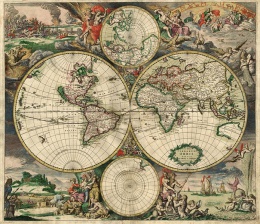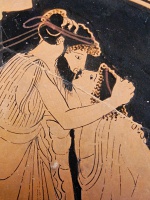Andron: Difference between revisions
From BoyWiki
No edit summary |
No edit summary |
||
| (One intermediate revision by the same user not shown) | |||
| Line 1: | Line 1: | ||
{{History}} | {{History}} | ||
'''Andron''' ([[Ancient Greek|Greek]]: Ἀνδρῶν-ῶνος), or '''Andronitis,''' is part of a Greek house that is reserved for men<ref>[https://en.wikipedia.org/wiki/Man_cave See: Man cave (Wikipedia)]</ref> and was used for entertaining male guests.<ref>{{cite journal|last=Coucouzeli|first=Alexandra|title=From Megaron to Oikos at Zagora|journal=British School at Athens Studies|year=2007|volume=15|page=173}}</ref> [[Symposium| | '''Andron''' ([[Ancient Greek|Greek]]: Ἀνδρῶν-ῶνος), or '''Andronitis,''' is part of a Greek house that is reserved for men<ref>[https://en.wikipedia.org/wiki/Man_cave See: Man cave (Wikipedia)]</ref> and was used for entertaining male guests.<ref>{{cite journal|last=Coucouzeli|first=Alexandra|title=From Megaron to Oikos at Zagora|journal=British School at Athens Studies|year=2007|volume=15|page=173}}</ref> [[Symposium|Symposia]], social events with food and wine, were held in the andron. For this purpose the andron held several couches, usually an odd number to allow space for the door, tables which could be tucked under the couches, artwork and any other necessary religious and party paraphernalia, such as a [[Krater]], [[Kylix|kylikes]] and amphoras of wine. | ||
Not all classical Greek houses were large enough to have a dedicated andron, and even those that did might have used the room for mixed-gendered events and women receiving female guests, as well as men hosting | Not all classical Greek houses were large enough to have a dedicated andron, and even those that did might have used the room for mixed-gendered events and women receiving female guests, as well as men hosting symposia.<ref name=Coucouzeli07-194>{{cite journal|last=Coucouzeli|first=Alexandra|title=From Megaron to Oikos at Zagora|journal=British School at Athens Studies|year=2007|volume=15|page=174}}</ref> | ||
==References== | ==References== | ||
Latest revision as of 23:28, 2 July 2022
| Part of the boylove history series |
 |
| Portal:History |
Andron (Greek: Ἀνδρῶν-ῶνος), or Andronitis, is part of a Greek house that is reserved for men[1] and was used for entertaining male guests.[2] Symposia, social events with food and wine, were held in the andron. For this purpose the andron held several couches, usually an odd number to allow space for the door, tables which could be tucked under the couches, artwork and any other necessary religious and party paraphernalia, such as a Krater, kylikes and amphoras of wine.
Not all classical Greek houses were large enough to have a dedicated andron, and even those that did might have used the room for mixed-gendered events and women receiving female guests, as well as men hosting symposia.[3]
References
- ↑ See: Man cave (Wikipedia)
- ↑ Coucouzeli, Alexandra (2007). "From Megaron to Oikos at Zagora". British School at Athens Studies 15: 173.
- ↑ Coucouzeli, Alexandra (2007). "From Megaron to Oikos at Zagora". British School at Athens Studies 15: 174.
